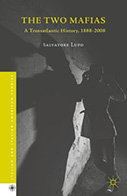The Two Mafias: A Transatlantic History, 1888-2008

Author: Salvatore Lupo
Publisher: New York: Palgrave Macmillan, 2015. 236p.
Reviewer: Klaus von Lampe | July 2017
Salvatore Lupo’s The Two Mafias is an important contribution to an emerging body of literature that seeks to provide a sober, comprehensive analysis of the transatlantic ramifications of the Sicilian Mafia. The focus is not so much on the historic roots of the American Cosa Nostra, but on the links between mafiosi in Sicily and in North America that have persisted over decades even though their nature has changed, and ultimately, Lupo suggests, they may now be “close to being destroyed once and for all” (p. 3).
Lupo, a Professor of Contemporary History at the University of Palermo who has previously written an influential history of the Sicilian Mafia (Lupo 2009), explains in the Introduction that his
…. study examines two Mafias-Sicilian and American-that had similar “customs” and “criminal philosophy.” But those similarities are due neither to “an arcane legacy transported to urban America from provincial Sicily,” nor to a transplantation from one world to another. The two Mafias evolved in an ongoing process of interconnection and hybridization within an intercontinental network that linked individuals, interests, ideas, and places (p. 2).
The Two Mafias is divided into seven chapters, the first six following chronologically the developments beginning with the Italian migration to the U.S. in the second half of the 1800s to the Italian involvement in the transatlantic drug trade of the 1970s and 1980s. In the last chapter, Lupo discusses various interpretations of the Mafia phenomenon.
In his historical analysis, Lupo draws on archival data, including “some extremely enlightening official Italian documents from the 1920s and 1930s” (p. 6), as well as the existing academic and non-academic literature, which includes some autobiographical accounts that have met with a great deal of skepticism in the past. Lupo carefully compares the various sources and assesses their credibility in search of the most plausible interpretation of events.
A recurring theme that is carried over from his previous work is his insistence that the mafiosi who came to America were not peasants bound by an archaic culture, but rather enterprising individuals who ventured to the United States for reasons other than to escape poverty. Lupo also emphasizes that these mafiosi did not sever their ties to Sicily. In fact, many of them travelled back and forth across the Atlantic or returned to Italy after spending time in America, forming a “bridge connecting the original Sicilian Mafia and its American byproduct” (p. 27) and shaping the Mafia into “a transatlantic phenomenon” (p. 33).
While Lupo establishes as a fact the presence of Mafia groups in the United States by the 1920s, he does not see them in a dominating position in the underworld. The one development during Prohibition that Lupo highlights is the integration of Italian criminals into “the mainstream of criminal business, taking part in powerful interethnic partnerships” (p. 40). This pertains not only to Sicilians, but also to immigrants from other parts of Southern Italy, more specifically those areas apart from western Sicily that also had “criminal traditions” — Calabria and Campania (p. 42).
Lupo devotes much of the third chapter to the deconstruction of the so-called Castellammarese War, the alleged 1931 purge of the American Mafia from conservative Sicilians who supposedly stood in the way of a process of ‘Americanization’. Lupo comes to the conclusion that “the purge is an invention, or better, it is a legend” (p. 76), although he notes that there was indeed a sharp decline in violence among Italian-American criminals in the first half of the 1930s. What Lupo suggests is that the events of the time, including the famous killings of “Joe the Boss” Masseria and Salvatore Maranzano, and the ascent to prominence of Lucky Luciano-the Americanized gangster par exellence-, did not diminish the influence of the Sicilian factions — the only ones in the Italian underworld, Lupo stresses, who maintained transatlantic ties. More to the contrary, of the five “families” it was only the one led by Luciano where “non-Sicilians played leading roles,” whereas the others “were ruled by so-called ‘old-type’ Sicilians” (p. 77). He also points out that at the infamous Mafia gathering near Apalachin, New York in 1957, most of the attendees had been born in Italy, and of those the overwhelming majority came from Sicily.
In the years leading up to Apalachin, the Mafia had received increasing public attention, especially through televised hearings held by a Senate committee under Estes Kefauver, who was later blamed for uncritically accepting a narrative provided by Harry Anslinger and his Federal Bureau of Narcotics (FBN).
Lupo, in his examination of the 1940s and 1950s, rehabilitates to some extent the FBN by acknowledging that “something like a Mafia conspiracy really did exist” in the transatlantic drug trade (p. 113). But this conspiracy, according to Lupo, neither amounted to a “single global, monolithic corporation” (p. 139), nor did it mark an expansion of the Sicilian Mafia across the Atlantic. The transatlantic conspiracy consisted of mafiosi from both sides of the Atlantic with the American element being the driving force: “the Sicilian Mafia was involved in the narcotics trade only because of its connection with the American Mafia” (p. 138).
The Mafia bridge across the Atlantic that Lupo describes is primarily one between the Bonanno family in New York and mafiosi in Castellammarese, Sicily. This connection, he suggests, was “terminated for good” (p. 159) in the early 1980s in the course of the violent internal conflict that ended with Toto Riina’s rise to power within the Sicilian Mafia. The links between the two Mafias were further weakened when in the mid-1980s, in the era of the Commission trial in New York and of the maxi-trial in Palermo, both organizations “were hit hard simultaneously, thus prohibiting Mafiosi from playing their old game of moving from one side of the Atlantic to the other when they were in trouble” (p. 183). Yet, Lupo hesitates to write the transatlantic Mafia network off completely. He ends his book with an appeal to law enforcement agencies in the U.S. and Italy to “continue to dismantle the Mafia’s ‘Old Bridge’ until it is only a memory, and no more than a topic of historical research” (p. 183).
The Two Mafias is a meticulous analysis of the historical record on the relationship between American and Sicilian mafiosi, and it is a profound critique of the academic debate of the past seven decades on the Mafia in the United States.
Klaus von Lampe, John Jay College of Criminal Justice, New York


